Invicta Flies - Model 321
In general, when you consider tying up a few flies to catch largemouth bass, there are advanced techniques, special materials, and the need for a substantial time slot involved. While the wonderful variety of bass flies are effective, colorful, and constitute an art form all their own, there are simple flies that are just as effective (and often more so) than the standard, time-consuming patterns. The Model 321 is one of them. Simple to tie, quick, inexpensive, and most importantly... they catch bass. You can, of course, make them as complex as you like, but the original tail-body-wing in bold colors continues to prove itself as the most effective. If you've hesitated flyfishing for bass, or your bass fly collection seems thin because of the complexity of most bass patterns, one evening of tying the 321 will get you on your way and fill your box with all the necessary colors to get you into some hard-fighting largemouths.
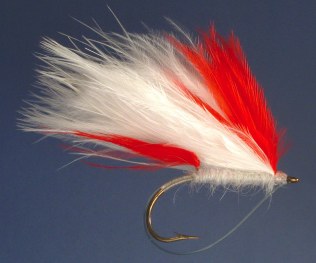 |
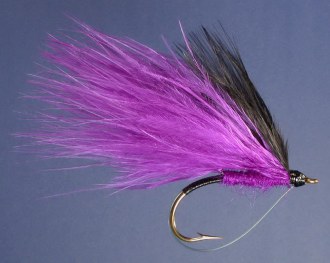 |
Hook: Mustad 3366, #2
Thread: 3/0 waxed Monocord, black or color to match
Weedguard: 20 lb monofilament
Tail: marabou
Body: Angora goat dubbing
Wing: marabou
*see Notes below for color variations
Tying Instructions:
1) Secure the thread to the hook shank just behind the eye and wind back to the bend, laying a foundation of thread. Cut a four inch piece of 20 lb. mono and lash one end to the top of the shank, working halfway down the bend. The excess should extend back beyond the bend. Wrap the thread back up to the shank tightly.
2) Gather a sparse bundle of marabou fibers for the tail. The tips do not have to be aligned, and in fact, an uneven bundle tends to blend in better with the wing. Tie this bundle in on top of the shank (and the weedguard) at the bend, making it as long as the entire hook. Trim the excess at a taper and cover with several wraps of thread. Wind back to the tail. Now lift the tail and take five or six turns of thread around the bundle only in a counter-clockwise direction then pull the thread toward the front of the fly to lift the tail. Take two turns of thread around the shank just in front to anchor it in place. You should end up with the tail pointing up 60-90 degrees, similar to a parachute post. This helps keep the tail from fouling when the fly is fished. Apply cement or superglue to the post wraps, and the wraps securing the weedguard along the bend.
3) Dub a body up to about two hook-eye widths behind the eye. If you struggle with Angora goat dubbing, try this: Use very sparse amounts and spread the "pinch" out before twisting onto the thread. Do not use dubbing wax. Pinch-roll the dubbing very tightly, "folding" any stray fibers at the top and bottom of the bundle. If you have a rotary vise, use the feature to wind the dubbing along the shank, otherwise, pull down and retwist the dubbing if it loosens while wrapping. Use two or three layers to build up the body. You can also use rabbit, Sparkle Braid, or chenille. Personally, I like the looks of the Angora goat on this fly the best, and it helps create a neater head when the fly is completed.
4) Select two marabou feathers with very thin stems (blood marabou works well, but is not necessary). Trim them so they are both two and a half times the hook length. You will probably see a slight curve in them. Place them back to back (concave sides together), stroke them to gather the fibers, and tie them in together on top of the hook shank just in front of the body (two hook-eye widths behind the eye). Trim the excess to a taper and take several wraps of thread to the eye and back. Don't be concerned if the feathers twist out of alignment, although the best position is for both feathers to lie flat on top of the shank... as long as the feathers are positioned on top of the shank and lean back over the tail, the fly will fish well.
5) Gather a bundle of marabou about three times as thick as that used for the tail. Here again, the tips of the fibers do not necessarily need to be aligned. Tie this bundle in directly over the wing, extending for about half its length. Trim the excess to a taper, and cover completely with the tying thread.
6) Bring the weedguard up through the hook eye and take a couple wraps of thread to hold it. Mark at the hook eye on the mono with permanent marker, then pull the mono through a half inch or so. Trim the mono about 1/4 inch in front of the mark, then use a lighter to melt the mono back to the mark, creating a ball at the end. Pull the mono back through the thread into position, the melted portion preventing it from slipping all the way out, tighten the thread, and take several more tight turns of the thread to secure. Whip finish the thread and apply a thin, penetrating cement or superglue to the head.
Notes: The colors that produce in a given area may differ from others. Additionally, one color may work well one time, another color the next time. For me, the staple colors are red/white and purple/black. An all black with gold or multicolor flash added also produces well. There are times when none of these produce, but other colors will, such as green/chartreuse, or blue. Tie a variety, using proven color combinations as a guide.
|
 |
|
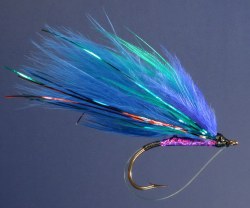 |
To add flash, simply tie in several strands of Flashabou on each side of the wing just before bringing the weedguard forward. When using chenille or mylar for the body, lash the excess from the tail to the top of the hook shank to create a smooth underbody. You can also add eyes if you like, but I find this does not seem to add to the fish-appeal for this particular pattern. If you plan to add eyes, make the head quite a bit larger to accommodate.
|
To fish: Another fine attribute of the 321 is that it's easy to cast. A five or six weight is sufficient unless you anticipate some larger fellows which call for heavier rods (keep in mind you may have to pull the bass out of weeds). Initially, it will want to float. You can either fish it as a surface fly until it soaks up water, or swish it to soak before casting. This fly runs shallow unless you've added weight or use a sinking line. Cast to shallow weedy areas or structures where bass are likely to hang. When the fly hits the water, count down: 3 - 2 - 1 , then strip with one sharp tug. Count down again, then strip with two sharp tugs. Count down again and strip three times. This is, of course, where the name comes from. Essentially, give the fly time to sink and vary the retrieve with sharp strips of the line. Most of the bass I've caught hit on the sink at "2" or "1" and immediately turn to go back to where they came from. Watch the line for any backward pulls and set the hook well.
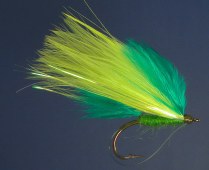 |
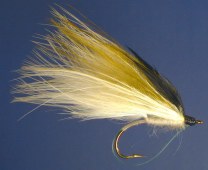 |
 |